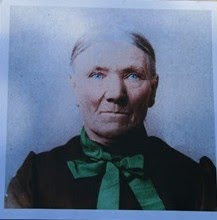 |
| Louisa Marshall Boyce |
Louisa Marshall Boice was born March 12, 1850 in Herefordshire, England to Sarah Goode Marshall and Thomas Marshall. Her father died when she was about three years old. Because Louisa's mother was a convert to the Church of Jesus Christ of Latter-day Saints, she brought her family to Utah in 1856. They suffered many hardships along the way, but according to Louisa, 'Through the faith and prayers of my dear mother we were able to stand it all.'
When they arrived in Salt Lake City, Louisa spun and knit to help her mother support the family. Louisa spent her girlhood in Franklin, Idaho. She first met her husband, Martin Calvin Boice, in Smithfield, Utah in the fall of 1864. Martin later moved with his parents to Oxford, Idaho with the help of Louisa's brother-in-law B. H. Hunt. When B. H. Hunt and Louisa's sister moved to Oxford, Louisa came with them and met Martin again. They were married on May 7, 1865 in Oxford and settled there. They became the parents of 12 children: five boys and seven girls. In 1869, Louisa and Martin made a trip to Salt Lake City to receive their endowments. One summer they stayed in Market Lake, Idaho to help Louisa's older sister and her husband. Their little boy had been killed when a wagon ran over his head. Louisa took her sister's place as cook at the home station stage line that they were running.
When the Oxford Relief Society was organized, Louisa served as a teacher. In 1879, Louisa and Martin sold their home in Oxford and moved to Dayton, Idaho. Louisa was Relief Society President there for 11 years. Then, they moved to Cottonwood Valley, Idaho where they ran a dairy for eight years. Finally, in 1901, they moved to Lovell, Big Horn, Wyoming where a group of Saints had been sent to colonize. Martin died there on October 5, 1907, and Louisa passed away on May 5, 1926.
 |
| Louisa Marshall Boyce / Boice |
This collection contains items relating to Louisa and to her mother, Sarah Goode Marshall. There is some discrepancy between the authors of the collection as to Louisa’s first name. In the autobiography she is identified as Louise, in the ‘Faith Promoting Incident’ one of her children refers to her as Louesa, and in Sarah Goode’s biography a grandchild refers to her as Louisa. Two items in the collection are about her specifically. The first item is a one-page typewritten autobiographical sketch of Louisa’s life written March 12, 1923 when she was 73 years old. In the sketch she recounts the moves that she and her husband made, and focuses on the eternal nature of the family. She notes that all of her children, except two sons who died in infancy, were worthy to go through the temple. She closes the account of her life with this statement: ‘I am looking forward to the time of when we will all be reunited again and have during my life tried to live worthy of the blessings of God on myself and family.’
The second item is entitled ‘A Faith Promoting Incident,’ and was written by one of Louisa’s children. Louisa was living in Dayton, Idaho in 1886 when the incident occurred. The saints were in the midst of persecution because of polygamy, and further, an influenza epidemic was going through the community. Louisa and her mother were both ill. One night, Louisa’s husband went out to check on her mother. While he was gone, Louisa heard someone at the door scraping his shoes. When she opened her eyes she saw a stranger standing in the middle of the room, surrounded by a bright light. She often said later, ‘I have never in my life seen anything to equal the brightness of that light. I could not move or speak a word.’ The Man said, ‘I have come to tell you how things are going with the Saints.’
At this moment she was instantly healed, and she began to pray fervently. Then she started to sing ‘Up Awake Ye Defenders of Zion.’ She was joined by hundreds of voices who she then led in singing ‘Lo the Lion’s Left the Thicket.’ In a vision, ‘the future was opened to me as far as my eyes could see in every direction.’ She saw people walking the highway in a destitute state, and she saw the White House and soldiers marching towards it in defense of the nation. The visitor informed her that ‘in a short time the Saints would be granted their franchise and in time they would hold the reins of government.’ Louisa was filled with happiness and asked the man to come again. He agreed and left the room.
Publisher's Note: Lovinia Marshall Adams lived at Market Lake, son John William Ezekiel Adams [male] 14 Mar 1867 Market Lake, Jefferson, Idaho died 17 Jun 1869 Fort Hall, Bingham, Idaho and Buried: 19 Jun 1869 in Roberts, Jefferson, Idaho.

















